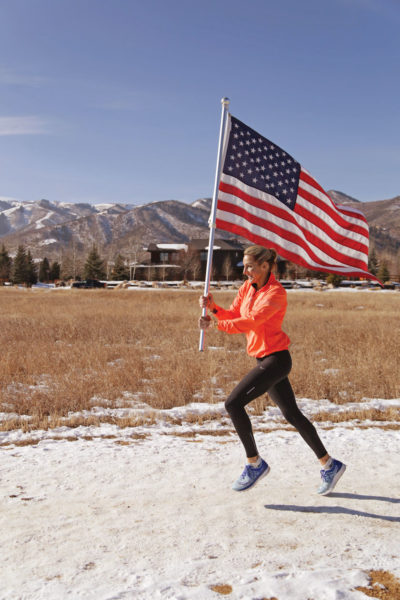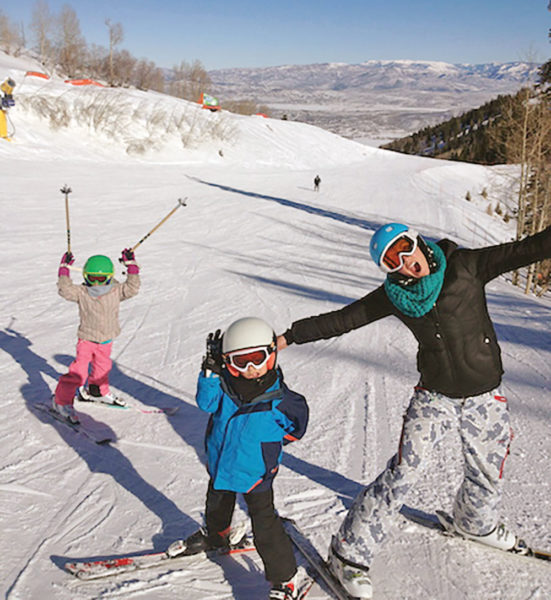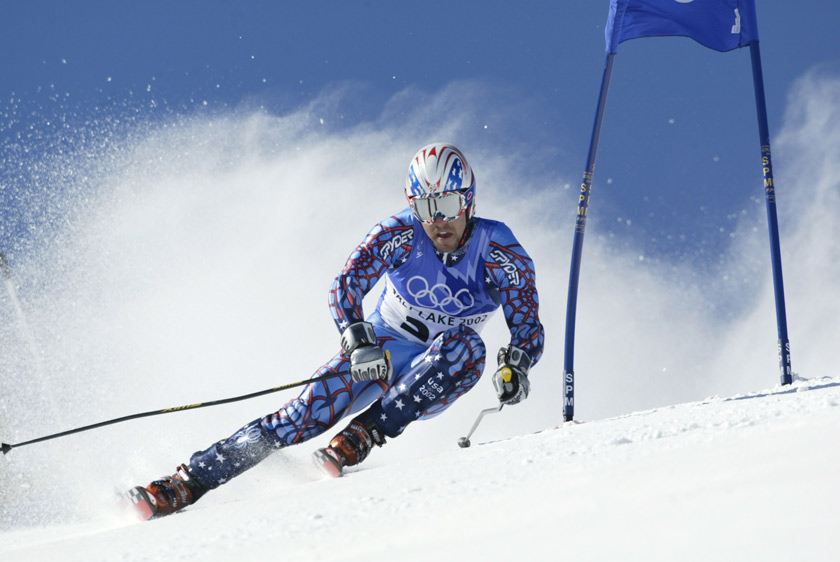Getting Horizontal: Erik Schlopy competing in the Olympic Men’s Giant Slalom in Park City, Utah, in 2002.
Credit: Mike Powell/Getty Images Sport
Did you know that as your altitude increases, so does your risk for skin cancer? More radiation reaches you up there. Skiers (who go high), pilots (higher) and astronauts (highest) have all experienced the consequences. We talked with extraordinary achievers who have learned to protect themselves — and who explain why they chose to enter a field with so many dangers. In part 1, we start with ski racer champion Erik Schlopy in Park City, Utah. In Part 2, we feature NASA pilot Charles Justiz, PhD. And in part 3, we hear from astronaut Scott Kelly, who spent a year on the space station.
Who:
Olympic athletes Erik Schlopy and Summer Sanders
Activity:
Competitive skiing and swimming; hiking and running for fun
Notable achievement:
Nine Olympic events between them
Adorable fact:
The whole family skis together
Type of altitude:
Mountain
Place:
Park City, Utah, when home
Level of altitude:
7,000 to 10,000 feet
Athletes Erik Schlopy and Summer Sanders love their life at high altitude in Park City, Utah, where every direction you look reveals idyllic mountain vistas for skiers, bikers, hikers and runners. The two elite athletes and their kids, Skye (14) and Spider (12) do all those activities and more, under a brilliant blue sky and a sun that blazes with ultraviolet ferocity.
For all their craggy beauty, mountains present the potential for danger, and not just from the sun. Erik didn’t achieve one of the longest and most successful careers in U.S. ski racing history by letting fear get in his way. “You’ve got to understand gravity,” he says with a chuckle. “And you’ve got to be willing to accept that there’s a lot of risk. You are going to get injured. It’s not a matter of if but when.”
Over his nearly 20 years as a World Cup skier, he sustained four knee injuries requiring surgery, plus a broken back — always during competition. “But the scariest one,” he recalls, “was in Japan, at the 1993 Alpine World Ski Championships. I was there to race in the giant slalom. I went 280 feet in the air, dropped 100 vertical feet, and when I landed, I compressed six vertebrae and displaced my sternum. I almost completely bit off my tongue. I blew out my elbow. I’m lucky I didn’t die — and very lucky I wasn’t paralyzed.”
His recovery, he says, was almost miraculous, even though it took months of rehab. Despite the ongoing risks, he never gave up. He competed in three Olympics (in 1994, 2002 and 2006) and achieved 17 top-10 results in World Cup races. And he never stopped believing skiing was fun. “You know what? I’m so lucky. Yes, even after four knee surgeries and a broken back, I can still go out and play tennis and basketball, run and play and jump. I feel great. Skiing is a lifelong endeavor. And those who love it are able to share it with their friends and their family until late in life.”
Erik started skiing when he was 2, in the snowy hills of Buffalo, New York, where both his parents were ski instructors. (Yes, they all remain passionate Bills fans.) When he was 12, the family moved to Vermont. “That’s where I got into the mountains,” he says. And he was hooked.

Heart and Soul: Summer has been running so long at high altitude, she makes it look easy, even when carrying a flag on Memorial Day. She also pledges allegiance to sun protection! Credit: Summer Sanders
Meanwhile, Summer Sanders was down at sea level in Roseville, California, where she started swimming in the backyard pool before she was 2 and soon took to the water like a fish. She started training outdoors in the unrelenting California sun, and went on to win four Olympic medals in swimming at the 1992 Olympic Games in Barcelona. But even at mile-high training sites in Colorado, sun protection was not part of the program. “My mom would occasionally say, “Put sunscreen on, you’re getting red.” Sometimes I listened to her, and sometimes I didn’t. The coaches were always putting on hats and sunscreen, but for the most part, they never spoke to us about it, and we didn’t think about it. I regret that now.”
Summer was living in New York in 2003 while working as a TV host, commentator and correspondent when she agreed to go on a blind date with Erik, who was in town for a fundraiser for the ski team. She was nervous, she recalls. “But I knew, within the first 15 minutes, that he was the one.”
When she first joined Erik in Park City in 2004, Summer thought it was gorgeous and found it easy to fit in. “I did have to learn about the altitude and the intensity of the sun,” she says. Ten years later, she noticed a small, dark-brown spot on her right calf. Erik suggested she get it checked out. Her instincts kicked in, and while her dermatologist was somewhat concerned about the spot, Summer pushed for him to perform a biopsy right then. Not waiting was the right decision, as it turned out to be a melanoma, which can be dangerous, even life-threatening, if not detected very early.
She went on to find two more small spots that also were diagnosed as melanoma and also, thankfully, caught very early. “My moles don’t fit in the parameters of changing quickly enough to warrant removing them,” she says. “But every mole that I have fought to have biopsied has come back melanoma.” She is glad she educated herself, trusted her instincts and was brave enough to say something.
Coincidentally, Erik has a family history of melanoma, so he must be vigilant as well, especially because of his life at high altitude. Luckily, while skiing, he’s usually pretty well covered up. “When I was younger,” he recalls, “Nobody was putting on sunscreen. We were training on glaciers, which are very reflective. The one benefit we had was being fully clothed, and we had helmets and goggles on. Although, yes, our nose, cheeks, mouth and chin were exposed.” He adds, though, “Believe me, if Summer sees anything new or weird or changing on any of us, she’s going to alert us and get us checked out.”
Spider and Skye do take after their parents. “Both are great skiers,” Erik says. “Spider has decided to go full time into ski racing. And he has a wonderful feel for the snow. Skye’s first love, though, is equestrian. She’s a beautiful rider.” What about sun protection for the younger generation? “Let’s just say Summer has a high intensity level when it comes to making sure the kids have sunscreen, sun-protective clothing and hats on!” Erik says. With the right sun protection, the family takes full advantage of the Park City outdoors, whether it’s hiking in summer or skiing in winter. As Erik puts it, “I’m still like a kid when I ski. It’s like being in a big playground. The ultimate victory is the lifelong enjoyment.”

Family Playtime: Erik (behind the camera for this shot of Skye, Spider and Summer) is proud that both his kids and his wife are good skiers. But he’s even more proud that they can all go out together on the slopes and just play and have fun. Credit: Summer Sanders






